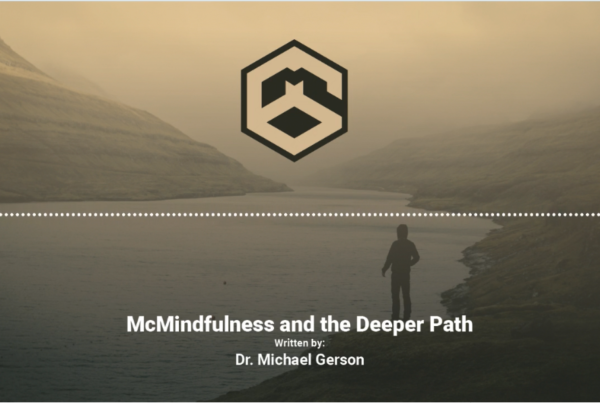“For that moment your image of yourself was lost in the gestalt, in the totality of the moment. You were not clinging to anything. You were not holding on to the experience. It was flowing—through you, around you, by you, in you. At that moment you were the experience. You were the flow.” -Ram Dass
It is said that we are spiritual beings living a human existence. However, for many in the West this idea has been lost. In our culture the mind or intellect reigns supreme and the spirit has mostly been relegated to the basement of our wellness paradigm, if not altogether forgotten. The spirit, however, is our source of connection to self, other, and to a higher power. Investing in our internal essence can provide us with many benefits such as more ego awareness and access to “the now.” It can also allow us to see ourselves in others and others in ourselves, and to witness our place in the larger web of the universe. By nurturing what is known as the “seat of the soul,” we can become more centered, other-focused, and harmonious with the existence of all things and non-things. Thus, cultivating the spirit puts us on a pathway towards improving our quality of life and performance.
However, the spirit has been all too often neglected. Like politics it has been banished from discussion and exploration. Whatever the reasons are, too many to discuss in this blog, the world seems to be reaching a critical mass of change. The tipping point that is occurring in the world today, especially in the western hemisphere, is quite visible as more people are making room for spiritual practice. The proof is in the sheer number of articles, books, meditation apps, and centers that have sprung up over the ensuing decades. And so, with that being said, we state again that we believe that the time is ripe to rectify the split between spirit and performance.
So, how do we encourage this inner being and transform into spiritual warriors? One way to ignite our spiritual curiosity is by engaging in a regular meditation practice. This ancient method of sitting down and connecting to the breath or other anchor (body, sound, image) brings us and the moment into greater alignment and focus. Meditation is a teachable and trainable technology that can help us become more grounded, present-minded, open, peaceful, focused, and happy. It is a way to access the eye of the storm—that space found inside us all which is quiet and still—where we can respond to life’s obstacles with more poise, clarity, and wisdom.
Inside this sphere of serenity – the eye of the storm – lies a power source to boosting the voltage of our oft-neglected spirit. Nestled within resides three tools of spiritual renovation: mindfulness, concentration, and insight. At once, meditation helps to activate and grow these spiritual devices. The importance of these three instruments is that they hold a type of power that can help us to push and stretch the sacred circumference of the eye of the storm. Doing so gives us more space to respond rather than react to stressors and fills us with more equanimity, compassion, and joy. By expanding our inner place of tranquility, we become more skillful at handling the mental and emotional debris caused by the virulent vortex that we call life. We can deal more effectively with the cacophony of noise that swirls outside our center; a periphery fueled by incessant and misguided perceptions, unproductive thoughts, toxic emotions, and the hectic environment of modern-day life. Thus, we can consider this threefold training as a power-packed method that has the potential to connect, stabilize, deepen, expand, and enhance our sanctified space within.
These three powers are spiritual endowments and tools that permit us to move us from performance stupor to a performance that is super. Generating these energies is the keystone of any meditation practice and can help us to produce more flow and zone-like experiences. When athletes or performers maintain a psychological state in which one’s performance seems supernatural, we say that they are in “the zone” or experiencing optimal or peak performance. In his book, “The Mindful Athlete” George Mumford describes the Zone the following way:
- ultimate experience of optimal performance in sports
- eureka moments and breakthroughs in the arts and sciences
- happiness and glimpse into something much bigger and far more expansive than ourselves (Mumford, 2016).
When it comes to the zone there is no shortage of definitions. One such definition that I like is by Williams (2015) who defines this experience as “those magic moments when an athlete puts it all together—both physically & mentally.” As a former baseball player, I have achieved flow or the zone countless times throughout my career. During those times, it was as though I was able to transcend ordinary play, shifting to a supernatural state where I performed exceptionally. Those magical moments were marked by a complete detachment from the fear of failure. Instead, my mind was quiet and highly focused. It was as though all of those structures essential to performing a task optimally were online and fully engaged and all of those structures and mental processes that were nonessential dropped out. As the opening quote by Ram Dass suggests, I was lost in the totality of the moment, not grasping for anything, fully present, totally whole, becoming the experience.
The zone and flow are mostly used in a sporting context. However, this is a really limited view. This is why the authors greatly appreciate Mumford’s definition because it includes occupations and hobbies. The truth is that you can experience the zone in any field, role, or line of business. Mumford also mentions that the zone includes happiness, as well as a glimpse into something much bigger than the self. This is the part of the zone that is often neglected because of its tie to spirituality – yet, if it is cultivated, it can be used as a performance additive.
When it comes to entering the coveted zone, one must learn to surrender and let go – not forcing it. Like holding a wet bar of soap, the harder you squeeze, the more easily it slips away. Instead, one moves from making things happen to allowing things to become. In the sport psychology world this is called effortless performance. Other aspects of creating a peak experience include loss of fear, not thinking about the performance, total immersion in the activity, and a narrow focus—all aspects that can be argued positively impacted by cultivating the spirit.
References
Dass R. (1990). Journey of awakening: A meditator’s guidebook. Bantam Books.
Mumford, G. (2016). The mindful athlete: secrets to pure performance. Parallax Press.
Williams, J. & Krane, V. (2015) Applied sport psychology: personal growth to peak performance, 7th edition. McGraw-Hill.





